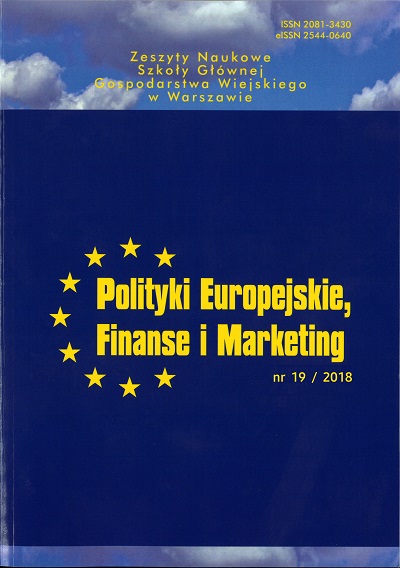Main Article Content
Article Details
Antala R. M., Sumandea-Simionescu I. (2015) Possible solutions to the question of insolvency - empirical analysis regarding the degree of exposure of the solvency of Romanian insurance companies. Procedia Economics and Finance 32 pp. 376-382.
Antonowicz P. (2011) Kształtowanie wartości brzegowych wskaźnika płynności finansowej i stopnia w przedsiębiorstwach w okresie trzech lat przed ogłoszeniem upadłości, ZESZYTY NAUKOWE UNIWERSYTETU SZCZECIŃSKIEGO NR 637 EKONOMICZNE PROBLEMY USŁUG NR 62.
Bancel F., Mittoo U. R., [2010] Financial Flexibility and the Impact of Global Financial Crisis: Evidence from France. Dostęp: https://papers.ssrn.com/sol3/papers.cfm?abstract_id=1587302 z dnia 10.11.2017
Bruinshoofd A., Kool C., (2002)The Determinants of Corporate Liquidity in the Netherlands. Long run targets and short run buffer stock dynamics in an error correction framework. Dostęp: http://digitalarchive.maastrichtuniversity.nl/fedora/get/guid%3Acefed64c-9ac7-4396-abe9-393b10fb812f/ASSET1/ z dnia 11.11.2017.
Campello M., Giambona E., Graham J. R., Harvey C.R., Liquidity Management and Corporate Investment During a Financial Crisis.
Canner G.B., Luckett C.A., Consumer Debt Repayment Woes. Insights from Household Survey, "Journal of Retail Banking" 1990, nr 12 (1), s. 55-62.
Carson J., Hoyt R. (2000) Evaluating the risk of life insurer insolvency: implications from the US for the European Union. Journal of Multinational Financial Management 10 pp. 297-314.
De Vaney S.A., Lytton R.H., Household Insolvency: a Review of Household Debt Repayment, Delinquency and Bankruptcy, "Financial Service Review" 1995, nr 4 (2), s. 137-156.
Fabling R. Grimes A. (2005) Insolvency and economic development: Regional variation and adjustment. Journal of Economics and Business 57 (4), pp. 339-359.
Gajda T., Jurkiewicz D., (2010) Ubezpieczenia w sektorze MSP w latach 2007-2010 (wyniki badań ankietowych) Ubezpieczenia w sektorze MSP 2007-2010, Wiadomości ubezpieczeniowe.
Georgescua I., Baciub E. (2014) The effect of economic crisis on eastern european insolvency. The effect of economic crisis on eastern european insolvency. Procedia Economics and Finance 15, pp. 784-791 dostęp: www.sciencedirect.com z dnia 08.11.2017.
Kupis P. Dysfunkcje postępowań upadłościowych - perspektywa wierzycieli. Ochrona rzeczywistego poziomu praw wierzycieli. Biuletyn PTE 2/2017.
Lea S., Webley P., Walker C., Economic Socialization and Credit Use, "Journal of Economic Psychology" 1995, vol. 16, Iss. 4, s. 681-701.
Mironiuc M., Taran A. (2015) The significance of financial and non-financial information in insolvency risk detection 4th World Conference on Business, Economics and Management, WCBEM Procedia Economics and Finance 26 pp. 750-756 dostęp: www.sciencedirect.com z dnia 09.11.2017.
Masiukiewicz P. (2016)Modele pomiaru i skala zatorów płatniczych w Europie. Ochrona praw wierzycieli. Biuletyn PTE, 4/2016.
Monokroussos P., Gortsos Ch. (ed), (2017), Existing Corporate and Household Insolvency Frameworks: Characteristics, Weaknesses and Necessary Reforms, w: Pagratis S., Lolou Ch., Nikolaos Vettas N., Non-Performing Loans and Resolving Private Sector Insolvency, Palgrave Macmillan.
Porada-Rochoń M., Franc-Dąbrowska J., Suwała R. (2017) Eliminating the Effects of the Companies Insolvency Risk: A Model Approach, World Journal of Applied Economics 2017, 3(1), s. 21-37.
Sullivan C., Fisher R.M., Consumer Credit Delinquency Risk. Characteristic of Consumers who Fall Behind, "Journal of Retail Banking" 1988, nr 10 (3), s. 53-64.
Świecka B. (2009), Bankructwa gospodarstw domowych. Przyczyny-skutki-przeciwdziałanie, Difin, Warszawa.
Świecka B. (red.) (2008), Bankructwa gospodarstw domowych. Perspektywa ekonomicznospołeczna, Difin, Warszawa.
Zajączkowski S., Żochowski D., Obciążenie gospodarstw domowych spłata długu - rozkłady i stress testy, [w:] J. Osiński, D. Tymoczko, P. Wyczański (red.), Raport o stabilności systemu finansowego 2006,.), NBP, Warszawa, maj 2007.
Downloads

This work is licensed under a Creative Commons Attribution-NonCommercial 4.0 International License.
All articles published in European Policies, Finance and Marketing are fully open access. In this way, the scientific research results contained in articles published in our journal are available to every reader free of charge - in accordance with the CC BY-NC license (https://creativecommons.org/licenses/by-nc/4.0/).
According to the CC BY-NC license you are free to:
- Share — copy and redistribute the material in any medium or format
- Adapt — remix, transform, and build upon the material
The licensor cannot revoke these freedoms as long as you follow the license terms.
Under the following terms:
- Attribution — You must give appropriate credit , provide a link to the license, and indicate if changes were made . You may do so in any reasonable manner, but not in any way that suggests the licensor endorses you or your use.
- NonCommercial — You may not use the material for commercial purposes .
- No additional restrictions — You may not apply legal terms or technological measures that legally restrict others from doing anything the license permits.
Source: https://creativecommons.org/licenses/by-nc/4.0/deed.en
According to that, the authors retain the copyright and full publishing rights.





